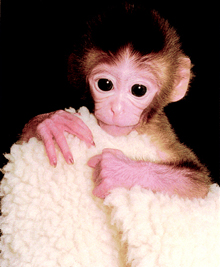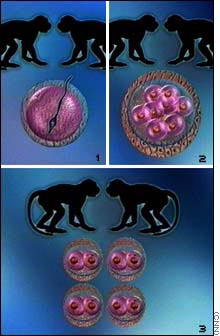Body Double
BEAVERTON, Oregon (CNN) — Oregon researchers say they have cloned a monkey by splitting an early-stage embryo and implanting the pieces into mother animals.
The technique has so far produced only one living monkey, a bright-eyed rhesus macaque female named Tetra, now 4 months old.


Tetra the monkey is different from Dolly the sheep, which was produced by Scientists at Scotland’s Roslin Institute using a process called nuclear transfer — taking the nucleus out of an adult cell and using it to reprogram an unfertilized egg.
Some scientists argue that animals like Dolly are not 100 percent clones because they have genetic material both from the adult cell they were taken from, and from the egg that is hollowed out to make the clone. Tetra was produced by a technique called “embryo splitting.” Here’s how it works:
* An egg from a mother and sperm from a father are used to create a fertilized egg.
* After the embryo grows into eight cells, researchers split it into four identical embryos, each consisting of just two cells.
* The four embryos are then implanted into surrogate mothers. Schatten said that in effect, a single embryo becomes four embryos, all genetically identical.

In the case of their experiment, three of the embryos didn’t survive. The fourth, Tetra, was born 157 days later. Her name means “one of four.” Tetra isn’t the first monkey to be cloned, but she is the first using the embryo-splitting technique. More are on the way.